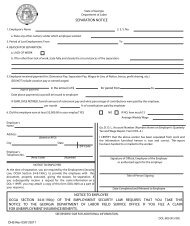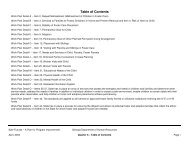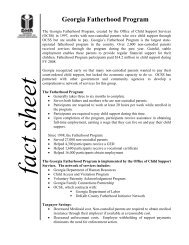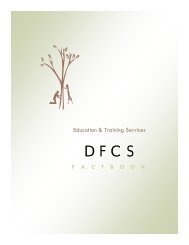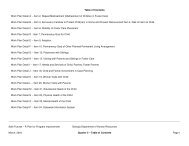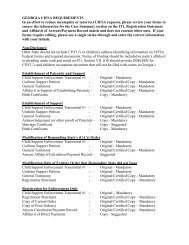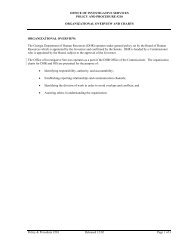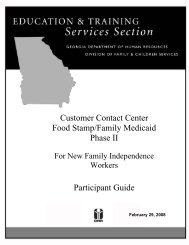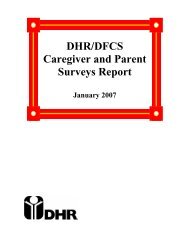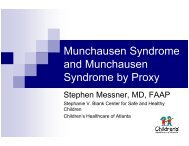an overview georgia program improvement plan - Department of ...
an overview georgia program improvement plan - Department of ...
an overview georgia program improvement plan - Department of ...
Create successful ePaper yourself
Turn your PDF publications into a flip-book with our unique Google optimized e-Paper software.
social-emotional (behavioral), educational needs, along with the proximity <strong>of</strong> <strong>an</strong> available foster home to their parents, etc.). The<br />
psycho-social/sexual behavior <strong>of</strong> some children is so provocative that placing their siblings with them compromises their safety <strong>an</strong>d<br />
well-being.<br />
Documenting the number <strong>of</strong> newly recruited homes willing to accept sibling groups is <strong>an</strong> on-going process. While Georgia directs<br />
considerable attention to its foster home recruitment efforts, the percentage <strong>an</strong>d types <strong>of</strong> homes needed statewide is very difficult to<br />
accurately establish <strong>an</strong>d track. This is partly due to the fact that children in need <strong>of</strong> care are a fluid population, me<strong>an</strong>ing that it is<br />
unpredictable how m<strong>an</strong>y children will come into care at a given time; how m<strong>an</strong>y <strong>of</strong> them are part <strong>of</strong> a sibling group; how m<strong>an</strong>y have<br />
issues or circumst<strong>an</strong>ces requiring separate <strong>an</strong>d/or specialized placements, etc. Georgia recognizes that as m<strong>an</strong>y children requiring<br />
placements into approved foster homes with their siblings are entering care, still others are exiting care, returning to their birth<br />
families, thus freeing up foster homes. Simult<strong>an</strong>eously, Georgia gives priority to placing children with their family members first,<br />
which me<strong>an</strong>s that relative resources c<strong>an</strong>not be identified until the child/children come into care.<br />
5 th Quarter DOCUMENTATION:<br />
Foster Care <strong>an</strong>d Adoption Services Recruitment Statistics -- Fulton <strong>an</strong>d Appling County DFCS<br />
6 th Quarter Report: The state considers this item achieved. The curriculum for training foster parents is being revised <strong>an</strong>d will<br />
include a specialized segment on m<strong>an</strong>aging sibling groups. The revisions are scheduled to be completed by June 30, 2004.<br />
Monitoring our progress in this regard will be on-going as new homes are recruited <strong>an</strong>d approved.<br />
6 th Quarter Federal Response: State should continue to monitor the progress in this area in the subsequent quarterly reports.<br />
G7: As per the State's request to renegotiate <strong>an</strong> evaluation method for the benchmark, the State must produce information verifying<br />
that '5% <strong>of</strong> all new foster homes will accept sibling groups.' A baseline will need to be established.<br />
7 th Quarter Report: The recruitment <strong>of</strong> placement resources is <strong>an</strong> on-going activity within the Division. Therefore, our efforts <strong>an</strong>d<br />
accomplishments continue to be monitored. The most recent data from the Foster Care <strong>an</strong>d Adoption Recruitment Quarterly Reports<br />
for April 2004 – June 2004 indicates that <strong>of</strong> 3,020 approved <strong>an</strong>d active foster homes, 1,284 were identified as accepting <strong>of</strong> sibling<br />
placements. This represents fifty-four (54) per cent <strong>of</strong> the total population. During the second quarter, <strong>of</strong> 2,382 approved <strong>an</strong>d active<br />
homes, 1,289 (54%)were willing to accept siblings. During the first quarter 2, 693 approved <strong>an</strong>d active homes were identified, <strong>of</strong><br />
which 1,440 (54%) were willing to accept sibling groups.<br />
In <strong>an</strong> effort to establish a baseline, as requested by the federal agency, we reviewed the totals for the first three quarters <strong>an</strong>d<br />
determined that <strong>an</strong> average <strong>of</strong> fifty-three (53) per cent <strong>of</strong> all approved <strong>an</strong>d active homes are willing to accept sibling groups. We<br />
Safe Future – A Pl<strong>an</strong> for Program Improvement<br />
Georgia <strong>Department</strong> <strong>of</strong> Hum<strong>an</strong> Resources<br />
November, 2004 Quarter 8 - Work Pl<strong>an</strong> G Page 7



